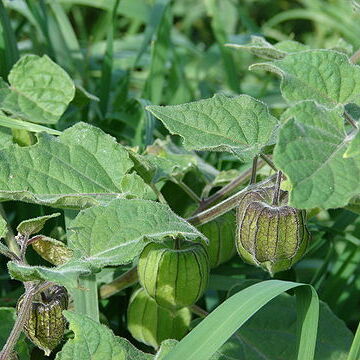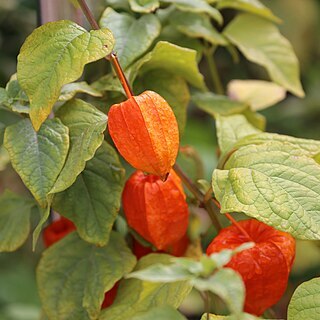Herbs annual or perennial, glabrous or pubescent with simple hairs. Leaves mostly equal, sometimes paired, simple, petiolate; leaf blade membranous, entire, denticulate or sinuate. Inflorescences solitary flowers in leaf axils or branch forks. Flowers actinomorphic, 5-merous. Calyx campanulate. Corolla yellow or white, often with a contrasting eye, rotate or rotate-campanulate, subentire or lobed. Stamens shorter than corolla, inserted at base of corolla tube; filaments sometimes expanded at base; anthers dehiscing longitudinally. Ovary 2-locular, ovules numerous. Stigma minutely 2-lobed. Fruiting calyx becoming enlarged, inflated, entirely enveloping fruit, membranous or leathery, with 5 or l0 longitudinal ribs, base often invaginated. Fruit a juicy globose berry. Seeds numerous, compressed, discoid or reniform, minutely pitted; embryo coiled, subperipheral.
Summer-growing annuals, rhizomatous perennials or short-lived shrubs, glabrous or pubescent with simple, forked or glandular hairs. Leaves alternate, 1 or 2 per node (but not opposite), when 2 unequal in size, simple, entire, toothed or lobed, petiolate. Flowers solitary in leaf axils and stem forks, bisexual, actinomorphic. Calyx tubular to campanulate, 5-lobed, enlarged in fruit. Corolla broadly campanulate to rotate, mostly yellow, often with dark spots towards the base; tube short; limb expanded, shallowly 5-lobed, folded in bud. Stamens 5, equal or unequal in height, inserted towards base of corolla-tube; anthers bilocular, basifixed, dehiscing by longitudinal slits. Ovary bilocular; stigma capitate. Fruit a berry enclosed by inflated calyx. Seeds disc-shaped to broadly reniform.
Unarmed annual or rhizomatous perennial herbs, sometimes subshrubs; hairs variable. Lvs alternate or opposite, simple, entire, toothed or sinuate, petiolate. Fls usually solitary, axillary. Calyx 5-toothed, campanulate, strongly accrescent. Corolla rotate or campanulate, usually yellow with an olive or bluish purple patch at base, 5-lobed or 5-toothed. Stamens 5; filaments attached near apex of corolla tube, exserted; anthers yellow or bluish violet. Stigma filiform or capitate. Fr. a globose berry, invested in the persistent, inflated calyx. Seeds numerous, lenticular, with patterned testa, of moderate size.
Calyx often as long as the corolla tube, campanulate or sometimes tubular-campanulate, 5-lobed to sub-truncate, the lobes if present as long as or shorter than the tube, often splitting at the sutures, conniving at the apex, with valvate aestivation; in fruit much enlarged and usually bladdery-inflated, often splitting at the sutures, loosely enclosing it (or elsewhere nearly so), 5-or 10-angled to-ribbed, sometimes ± terete, reticulate, often invaginated basally, contracted apically with a small opening surrounded by the lobes, remaining membranous or becoming chartaceous.
Stamens 5, mostly ± equal, usually inserted near the base of the corolla tube, ± included or slightly exserted; filaments slender (to nearly as wide as the anthers elsewhere), often ± straight, pubescent or glabrous; anthers oblong or linear-oblong to ovate in outline, straight or occasionally twisting and curling after anthesis, free or sometimes conniving, attached on the lower part of the back or at the base between the thecae, dehiscing by longitudinal slits.
Corolla yellowish to whitish, often blotched with 5 darker markings, campanulate, rarely infundibular-rotate (or elsewhere shortly infundibular); tube short, ± hairy inside above insertion of stamens and ± glabrous; limb plicate, subentire, sinuate, 5-angled or shortly and widely 5-lobed (to exceptionally 5-parted elsewhere), sometimes ± reflexed; lobes ovate-deltate (to subulate elsewhere), with imbricate-quincuncial aestivation.
Herbs or more rarely shrubs, sometimes sarmentose, glabrous to hairy; indumentum varied and often intermixed, the hairs multicellular (“jointed”) and short, unicellular, simple or occasionally stellate, often glandular or viscid, more rarely branched, also stipitate or sessile glands; rhizomatous structures sometimes present.
Seeds few–numerous, flattened, laterally compressed, suborbicular to reniform; testa somewhat leathery, slightly rugose or smooth, glabrous; embryo ± circinnate, flattened, subperipheral, in a fleshy or horny endosperm, with a terete radicle as wide as the semi-terete cotyledons.
Ovary 2-locular; ovules hemicampylotropous, few–numerous in each locule on a much enlarged, subglobose placenta adnate to the dissepiment near the axis; style slender to stout; stigma capitate to nearly truncate, sometimes 2-lobed to-lamellate, included or exserted.
Flowers solitary, extra-axillary or appearing axillary (elsewhere occasionally up to several flowers in small, axillary fascicles or rarely in terminal pseudoracemes), actinomorphic; pedicel slender, often elongated and drooping or nodding in fruit; bracts obsolete.
Leaves solitary, alternate, sometimes 2 or 3 appearing together, one larger than the others, petiolate, entire to coarsely lobed, rarely pinnatifid.
Fruit baccaceous, mostly ± globose, sessile or sometimes on a short gynobase, juicy or fleshy, often thin-walled, sometimes viscid, 2-locular.
Disk annular, adnate to and surrounding the basal part of the ovary, to none.


